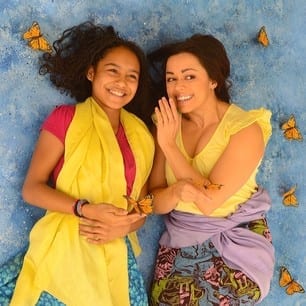SALT LAKE CITY — With the snow melted, cloudy skies, and still no leaves on the trees, northern Utah can be a dreary place in early March. But the Grand Theatre has a show to brighten Utahns’ mood and bring a little bit of the tropics to Salt Lake City. Once on This Island—a musical with a book and lyrics by Lynn Ahrens, music by Stephen Flaherty and based on a book by Rosa Guy—is a welcomed respite from the late winter blues, thanks to its tropical setting and the production’s warm, welcoming designs.
The story of Once on This Island is about a poor orphan woman named Ti Moune (Erica Nicole Walter) who finds a young man named Daniel (Steven Shoemaker) who survived a car accident. Ti Moune falls in love with him as she nurses him to health and, after Daniel returns to his home, Ti Moune treks across the island to find him. Unfortunately, Daniel is engaged to another woman, and the class and race differences between Ti Moune and Daniel seem insurmountable. The story is a mixture of folk tales and stories from human history, and many of Joseph Campbell’s motifs in his The Hero with a Thousand Faces describe Ti Moune’s story. The script is peppered with events and themes reminiscent of Romeo and Juliet, The Wizard of Oz, Beauty and the Beast, and more.
Director Alexandra Harbold grasped the mythical nature of the story and ensured that the show always had a mystic feel to it. Harbold created a stylized world for Once on This Island in which supernatural events seem probable. A realistic acting style and detailed backstory for characters would be incompatible with the script. The simple, presentational approach that Harbold used emphasized the story and played to the script’s strengths. Michelle Patrick‘s choreography augmented the Caribbean setting of Once on This Island. The rhythmic movement of “Rain,” “Mama Will Provide,” and “Some Say” were keys to the show’s success, and Patrick’s visual style meshed well with the score.
A production of Once on This Island depends greatly upon the charisma and talent of the actress playing Ti Moune. Thankfully, Walter has plenty of both. Her singing voice is clear and pleasant, and she made songs like “Waiting for Life” and “Some Say” fantastic to hear. Walter also imbued Ti Moune with the necessary emotions to make the story’s plot believable, such as in the love-at-first-sight moments and in Ti Moune’s willingness to face pain and trials for love. Walter also had excellent chemistry with Shoemaker, which made the interactions between Daniel and Ti Moune in the hotel scenes—especially the ball—wonderful fun to watch.
The other 12 members of the cast were superbly able to support Walter’s performance. Shoemaker is a great romantic lead, and his rendition of “Some Girl” was one of the best parts of the second half of the play. JD Dumas was pleasing as the rain god Agwe, and Dumas made “Rain” was a treat. Angela Chatelain Avilla was eye-catching as the earth goddess Asaka. Avilla’s maternal, nurturing bearing were sweet to watch, especially in “Mama Will Provide.” I also enjoyed the family dynamic between Ti Moune and her adoptive parents, Mama (Angela Trusty) and Tonton (James Titus), particularly when Mama and Tonton disagreed about Ti Moune leaving.
Although I enjoyed many aspects of the production, the strongest aspect of Once on the Island was Jeff Sturgis‘s lighting design. Sturgis ensured that every moment of the play was a visual joy. The lightning effects, the scenes with the gods, and the transition into “Pray” were all striking, thanks to Sturgis’s masterful work. Amanda Reiser‘s costume designs were instrumental in inviting the feel of the tropics into the indoor theater. I enjoyed most the loose, cool dresses worn by many of the women and the linen men’s pants—all of which would be ideal for a walk on the beach.
Once on This Island was nearly as flawless as possible for a non-Equity production, with only a few flat notes in the score marring an otherwise perfect evening. It’s the first production I’ve seen in 2014 that is worth seeing a second time, and I encourage readers to catch the show. After all, a visit to the Grand Theatre is cheaper than a visit to Hawaii or the Caribbean.







